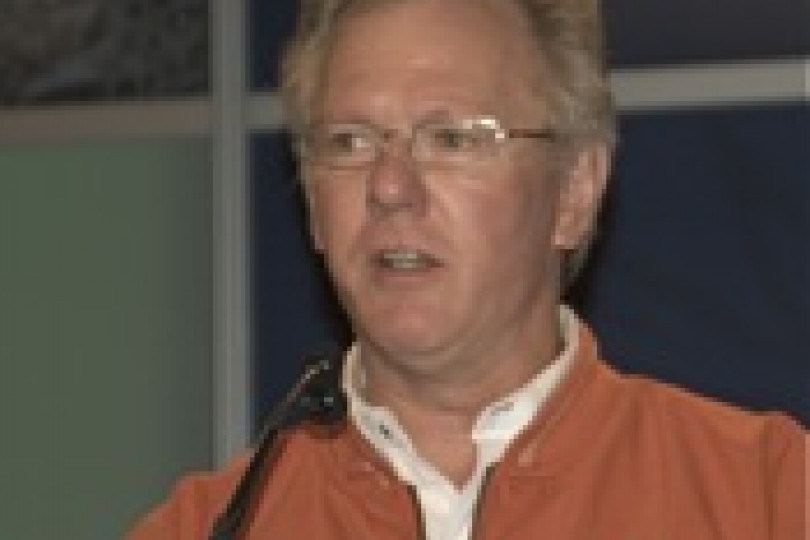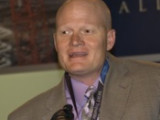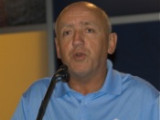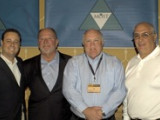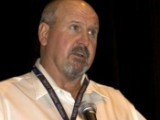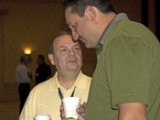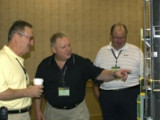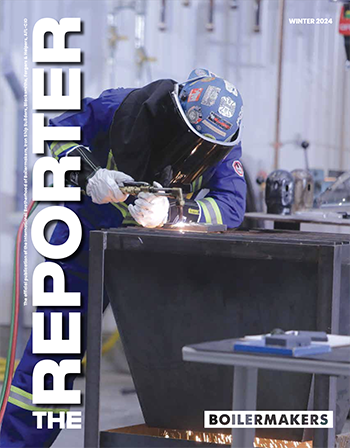Intl. Pres. Newton B. Jones discusses the MOST Boilermaker Delivery System.
View Photo Gallery (7 photos)
IP Jones details “revolutionary” manpower delivery system
THE FUTURE OF coal and nuclear power was a primary focus of the 24th annual National Tripartite Alliance Conference held in Myrtle Beach, S.C., Oct. 11-16. Industry experts — including a scientist, a leader in nuclear power development, and a legislative panel — addressed emerging technologies, political challenges, economic obstacles, and related issues.
Conference participants also received an update from International President Newton B. Jones on the latest tripartite initiative, called the MOST Boilermaker Delivery System.
MOST Administrator Bill Palmisano opened the conference with a tribute in absentia to Boilermaker International President Emeritus Charles W. Jones. Palmisano said Jones “had the courage and strength to recognize that a program such as MOST was sorely needed in the construction industry. He is today still the only international president [in organized labor] to have implemented a mandatory drug testing program for his members. No other craft has done that.”
Scientist calls carbon challenge next “moon shot”
“Canada is doing it [carbon capture and sequestration] right.”
— Travis McLing, scientist Idaho National Laboratory
GETTING CONTROL OVER carbon dioxide emissions in the United States is a challenge equivalent to the “moon shot” effort of the 1960s, a Department of Energy scientist told the conference. Travis McLing, who leads the carbon sequestration research program at the DOE’s Idaho National Laboratory, said it would take that kind of a national commitment to overcome a myriad of obstacles.
However, the growing menace of global warming — and an emerging threat to U.S. energy security — demand that the United States move forward, stressed McLing. Among the primary obstacles, he said, are the absence of a federal energy policy and the lack of an industrial-scale pilot program to test carbon capture and sequestration (CCS) methods. Also called “carbon capture and storage,” CCS refers to various methods of removing carbon dioxide from industrial processes and confining it deep underground or deep undersea.
McLing said that because of Washington gridlock, industry, investors, and state governments are uncertain of how to proceed with new power plants and the widespread application of CCS technologies.
“In 2003 and 2004 in the Northwest, there were about 13 advanced coal power plants that were on the drawing boards or had been announced,” McLing recalled. “Currently, there are zero that are getting ready to go online, simply because of the uncertainty.
“Canada is doing it right,” he said, referring to an $865 million CCS project in Alberta’s Athabasca oil sands region, financed by the provincial and federal governments. The money will go toward a large-scale pilot project to capture and store carbon dioxide at the Shell Canada Scotsford upgrader. “That amount of money — for this one project — is roughly equivalent to the total U.S. government budget for all seven regional carbon sequestration partnerships across the country,” said McLing. The U.S. partnerships are charged with developing the knowledge base and infrastructure requirements for commercialization.
Nuclear energy faces tough challenges, says industry expert
“We have in the U.S. what I refer to as a massive rush to be second” [to build a nuclear plant].
— Duncan Hawthorne, President and CEO of Bruce Power
DUNCAN HAWTHORNE, president and CEO of Bruce Power, discussed the future of nuclear energy and the challenges faced by owners, investors, and contractors. He said there are 440 nuclear reactors worldwide, with 67 under construction. “Many of them, not surprisingly, [are] in China and India and Russia — places that have a desperate need for power.”
Hawthorne said some of the projects his firm is involved with overseas have suffered major cost overruns and delivery problems. He cited a new plant in Finland that is coming in three years late and at twice its budget. “There’s currently a law suit over who pays for it. It’s a messy story.” A refurbishment project in Greece, “which should have cost $2.25 billion will instead cost $4 billion,” he added.
A major reason for these problems, said Hawthorne, is contractors have lost the capability and knowledge to take on large nuclear jobs. “There is not a single contractor, not one, who has worked on my projects that was capable of doing what they said they could do. Every one of them has had to learn on the project. Every one of them has had to recover their [former] position.”
Hawthorne said that’s one of the reasons no new nuclear power plants are being built in the United States. “We have in the U.S. what I refer to as a massive rush to be second,” he said. “Nobody wants to build the first plant, because it carries with it a lot of risk.”
He said the current focus on wind and solar power, along with the economic recession, also work to deter owners from starting new projects.
Panelists detail legislative push
“The lack of regulatory certainty has paralyzed owners, who must make decisions on capital expenditures.”
— Brad Bradford, consultant
A FOUR-MEMBER panel representing the tripartite partnership told conference participants about efforts to fashion an energy bill that takes into account the needs of the industry. John Gose, senior site manager for Consumers Energy, said that overall his company supports federal legislation... to control greenhouse gases. “We want [that legislation] to be reasonable and cost-efficient,” he stressed.
Gose expressed concern that without specific energy legislation the Environmental Protection Agency could set regulations that would be especially costly and difficult for owners.
Also serving on the panel were Abe Breehey, Legislative Director for the Boilermakers; Tony Jacobs, SAIPCSO; and Brad Bradford, consultant to the International President and consultant to BWCC. These three men have been working together to build a coalition of owners, contractors, and Boilermakers with the purpose of presenting a united front on Capitol Hill.
“We’ve tried hard to make our legislative approach a tripartite approach,” shared priorities, such as reasonable emission reduction targets, a fair share of allowances, and financial and regulatory incentives for carbon capture and storage.”
Jacobs said the tripartite approach to lobbying has worked well, and the coalition has held several meetings with U.S. Senate staff. “We have people who know the technology and can explain it. We have people like Abe that understand the workings in Washington, D.C. We have people like me, who as a common Boilermaker [can speak about Boilermaker jobs].”
Bradford observed that “the lack of regulatory certainty has paralyzed owners, who must make decisions on capital expenditures. It’s bad for contractors... [and] it’s bad for labor. The simple fact is the longer we delay and the more that action is deferred, the more difficult and expensive it is going to be for all of us.”
MOST Boilermaker Delivery System will increase productivity, save millions
A REPORT ON the MOST Boilermaker Delivery System (BDS) generated substantial interest among participants. Intl. Pres. Newton B. Jones said the system will revolutionize the way Boilermakers are assigned to jobs and will generate extensive, up-todate information on skill sets, worker allocation, and trends. The Web-based computer system will store member qualifications, job status, and other information. It will allow members to access and update their information and to indicate their availability and work preferences.
Under development for several years, the BDS is based on the online referral system developed by Canadian Boilermakers. It will enable contractors to place online job calls and will allow locals to more efficiently dispatch members to jobs. It will also provide efficient access to travelers.
IP Jones provided an overview of the proposed system, noting that significant progress has been made in the last year. One of the key benefits, he said, is that the system will help discourage job-hopping and related absenteeism by incorporating a uniform, nationwide penalty system. He said the BDS would improve productivity and save the industry millions of dollars.
Ken Wasilewski, general manager - Eastern Operations for Babcock & Wilcox Construction Co., reported that a study performed by his firm showed the rate of absenteeism, including that resulting from job hopping, averaged 6.6 percent in 2008 (for the 12 projects examined). He said the impact of absenteeism is so great that the rate always seems higher than it actually is. The actual cost of absenteeism can be substantial, he noted.
Jayne Clemance, MOST BDS program manager, demonstrated the system. Clemance said she has met with business managers and dispatchers at Local 154 (Pittsburgh) and Local 83 (Kansas City, Mo.) to develop a sense of how individual lodges operate differently.
Adopting the BDS will first require reforming the Boilermaker referral system. Jones pointed out that referral rules are not consistent from one local lodge to another. The rules also place hardships on travelers, who often must go long distances, at substantial personal expense, to keep their names on work lists. Moreover, existing referral rules create barriers to locals that wish to sign up new members. Establishing consistent referral rules for all construction locals and enabling members to access work lists via the Internet will help eliminate those problems, Jones said.
Don Powell, manager of purchasing and logistics for NRG Texas, urged all partners of the tripartite to support the MOST BDS. “This is a major effort that they [the Boilermakers] have undertaken, and I would like to thank them. This is a great example of where something tough has been tackled that is going to help all of us — the Boilermakers, contractors, and the owners, as we go to implement this.”
Virtual campus offers online training
GRANT JACOBS, CANADIAN National Training Coordinator, demonstrated the Boilermaker Virtual Campus, an online education and training system hosted on the Canadian Web site (www.boilermaker.ca). Since its creation three years ago, the campus has grown rapidly, offering numerous video and animated modules that allow members to learn at their own pace.
Jacobs said the national training trust fund has added online assessment testing for the Red Seal welder’s certification. Red Seal is a national certification program in Canada for the trades. All Canadian provinces are signatory to the program. Online assessment testing for the boilermaker Red Seal certification is under way.
Jacobs said the online campus is especially appealing to millennials (those born between 1980 and 1995), who are accustomed to using electronic forms of communication.
Speakers address other issues
CONFERENCE PARTICIPANTS heard from speakers on a range of other topics, including the national funds, the value of MOST, safety, substance abuse, and regional tripartite meetings.
IP Jones and Tom DelFiacco, vice president of the Segal Co., reviewed the status of the Boilermaker-Blacksmith National Pension Trust and the Officers and Employees Pension Plan with union participants. Because certain provisions of the Pension Protection Act were not suspended in 2009 as they were in 2008, substantial action will be needed to strengthen both funds. In addition, the Boilermakers National Health & Welfare Fund may require some adjustment. A number of options have been identified, and union trustees were expected to make a recommendation to the full boards of the various trusts before year end.
Common Arc Executive Director John Erickson highlighted MOST safety achievements over the years. He estimated that since 1991 the industry avoided 32,800 lost-time injuries and saved $5.7 billion in direct and indirect cost avoidance. Erickson said on a typical project MOST programs save a contractor $2.5 million. He added that the NACBE board has adopted new metrics and goals to measure safety progress. The initiative is intended to promote safety attitudes and behavior not only on the job but in workers’ daily lives.
MOST Safety Rep Roger Erickson reported on developments involving safety training. He said OSHA has made changes to the 10-hour and 30-hour courses and is conducting more unannounced audits to ensure classes are being taught as required. He cautioned that anyone committing fraudulent OSHA training faces criminal prosecution. Erickson said MOST-qualified trainers will benefit from a new 16-volume video library depicting actual Boilermakers. The library is nearing completion. He added that to date MOST has more than 360 OSHA-authorized trainers. It has trained over 42,000 students in the OSHA 10 course.
Director of Health and Safety Services Mark Garrett recalled his previous employment with a non-union construction company and the difficulty in getting good craftsmen who were drug free. “In my two years with the Boilermakers, I have visited so many construction projects and shops, and I see such a higher level of pride and quality. One of the main reasons is the MOST trust.” He said the tripartite approach offers amazing opportunities for communication and cooperation.
L-154 BM Ray Ventrone reported on the MOST Substance Abuse Intervention Committee. He noted that working as a construction Boilermaker can take a toll physically, and some members resort to self-medication. He pointed to the increased use of prescription pain killer Oxy-Contin, which has replaced cocaine as number two on the list of abused drugs. “We need to extend our hand to help our members, to make sure they don’t fall the wrong way.”
IP Jones praised the efforts of Ventrone and all business managers who are involved in getting their members help with substance abuse. He recommended creating a guide book explaining the program and how it works to reduce the apprehension members may feel in seeking help.
Area tripartite alliances provided short summaries of their annual meetings. Making the presentations were, for the Great Lakes, IR Pat Stefancin; for the Northeast Area and the Ohio Valley, IR Marty Stanton; for the Southeast Area, District 57 BM-ES Ed Vance; for the Upper Midwest, IR Tony Palmisano; and for the Western States, IR Jim Cooksey. (See page 6 for detailed reports on regional tripartite meetings.)
